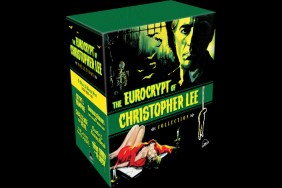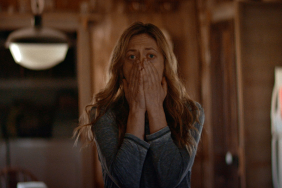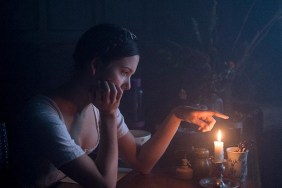
SHOCK’s Kat Ellinger continues her ongoing column, this time looking at the many erotic film incarnations of Le Fanu’s CARMILLA.
One thing that really sticks in my craw when it comes to vampire cinema is the dominance of the male form when it comes to filmic interpretations of the myth. Dont get me wrong, I love vampires in all guises be it found in books or film, poetry or music my never ending quest to consume as much bloodsucking action has been a lifelong passion; provoked by an accidental viewing of Hammers Dracula: Prince of Darkness (1966) when I was just six years old. For years, just like many people growing up in Britain in the seventies and eighties, my main staple diet of horror consisted of Hammer. It was through Hammer films that ironically (given my opening statement) Dracula came to be, and still remains, one of my greatest cinematic loves.I mean, who can resist the fiery menace, and pure sexualized power of Christopher Lee with his glowing red eyes? I know I cant, even now.
Through Lee, Hammer Studios resurrected the myth to convey the Count as a sexualized predator, which was a bold move for its day. But sex has always been a part of vampire lore when it comes to fiction, and the Count hasnt always dominated. Yet still, when we think of vampires in cinema, it is always to Dracula that we first tend to look. Historically, female vampires were cast out to the shadows or portrayed as acolytes to a dominant male leader; just like the banshees locked up in Draculas crusty old castle.

What is also often ignored when it shouldnt be, and not to take power away from Stoker, is the fact that prior to his seminal text, vampires already existed in literary form. John William Polidoris The Vampyre (1819) is widely credited as one of the first works of Gothic fiction to focus on the idea; although the legend is much older, hailing back through the ages in various disguises, in folklore and legend. In literature, especially poetry, we see the first seeds of Gothic vampirism hiding its ghoulish soul within the Romantic period. It was from here that Irish writer Sheridan Le Fanu was inspired to create his own vampire for his groundbreaking novella: Carmilla (1871-2) featuring a female vampire that predates Bram Stokers Dracula (1897) by 26 years; in a lesbian tinged tale played out on a strictly feminine playing field. It is fair to say Carmilla has been marginalised in cinema compared to her male counterpart with adaptations of the Count outnumbering the Countess tenfold at least. And this is why I have decided to focus on Carmilla specifically, in all her cinematic glory at least what there is of it to find for this edition of Go, Pussycat! Go!
Le Fanu followed in the footsteps of poetic work like Goethes Bride of Corinth (1859) a chilling story where a man is seduced, fed upon and killed by a female apparition that visits him in the night; or Johann Ludwig Tiecks Wake Not the Dead (1800) a husband bored with his good (but mundane) wife, wishes to resurrect a dead love, only to find in doing so the returning revenant feasts on his children and servants, before attacking and drinking his blood as he lies asleep one night. The Irish scribe took the female focused formula found in these glorious beginnings, while ramping up the sexual connotations for his own work. The tale told, with a subversive lesbian undertone, looks at the deadly relationship which develops between the lonely motherless Laura living on an isolated estate with only her distant father, and governess for company and an age old vampire Carmilla Karnstein. Le Fanus vampire infiltrates an innocent family, posing as a damsel in distress and after encouraging Laura to develop an infatuation with her, feeds on the girl during the night, penetrating her nightmares, and draining her lifeforce by drinking her blood. Carmilla comes with some really interesting readings in the subtext; such as the concept of immortality and loneliness, repressed sexuality and a Freudian dream element. Le Fanu is said to have been directly inspired by Samuel Taylor Coleridges unfinished poem Christabel (1797); within which a young girl finds a helpless maiden named Geraldine thought to have been attacked while out in the woods at night. Once Geraldine is taken in, a strange atmosphere develops, and although not specific, the sinister connotations and slight flavor of lesbian love ebb and flow throughout the prose.There are obvious connections between the two, although Le Fanu developed the ideas Coleridge left hanging in the ether of unfinished ideas, to flesh out a fully Gothic story.

When it comes to film the earliest hints of Carmilla Karnstein are said to be found in Dreyers Vampyr (1932), but are not obvious at all, even by stretching the imagination. Where we find the first real taste of Le Fanu is in a film that ironically falls under the namesake of Carmillas rival: Draculas Daughter (1936). Universals follow-up to Dracula (1931) Daughter took the similar route to Frankenstein (1931) and its sequel Bride of Frankenstein (1935), by giving matters a female focused slant. Although the screenplay is said to have been based on Stokers Draculas Guest (1914), the main protagonist Countess Marya Zaleska (played by the enchanting Gloria Holden) also carries some Carmilla-esque qualities especially in her penchant for female victims; shown in a scene where she preys upon a young artists model who she asks to partially undress before the attack and also through the main theme of loneliness carried by the Countess and she longs to be mortal. The train of thought that immortality is a void of suffering harks back to Carmilla, and from Draculas Daughter was carried forward into many of the films dealing with female vampires that followed. Usually, in the case of the male variety, vampirism is depicted as a source of power, or energy. By contrast, for women it is often seen as a curse.

A true adaptation woudnt arrive until 1960, with Roger Vadims highly underrated, and achingly beautiful Blood and Roses, or Et mourir de plaisir (Le sang et la rose). Updated to contemporary times Vadim manages to sneak in a period themed masqued ball (complete with a firework display), really embracing the Gothic aspect of the original story the Karnstein curse is resurrected by modern day ancestor Carmilla (Annette Vadim) when she puts on an old wedding dress and accidently stumbles into the family tomb. Possessed, or possibly mad with the grief that her beloved cousin Leopoldo (Mel Ferrer) is about to marry her best friend Georgia (Elsa Martinelli), Carmilla begins to act as if under the influence of a supernatural force; with a servant girl killed while out walking in the woods happening soon after. The film sets a benchmark in spelling out what Draculas Daughter was only able to whisper in hushed tones, bringing the lesbian angle to the foreground, and showing Carmilla seduce Georgia with an explicit kiss. However, despite this edge, the emphasis of Vadims interpretation becomes Carmillas obsession with Leopoldo the relationship with Georgia nothing more than a pivot for Carmilla to get closer to her desired (male) mate. If she can possess Georgia, she can have what she really wants. The film also indulges Le Fanus dreamscape aspect with an exquisitely surreal exploration into Georgias nightmares. The imagery in this haunting set piece contains some of the most fantastically artful visions to exist within the entire female vampire cannon (echoes of which are found in Tobe Hoopers Salems Lot (1979) with the infamous Danny Glick window tapping scene).
Just four years later and it Camillo Mastrocinques turn to dabble with Le Fanus text, in the Italian/Spanish co-production Crypt of the Vampire (La Cripta e lincubo). Following a distinctly Italian Gothic vibe this shot in black-and-white little number which incidentally was scripted by Ernesto Gastaldi; a writer responsible for some prime Italian Gothics such as The Vampire and the Ballerina (1960), The Horrible Dr Hichcock (1962) The Whip and the Body (1963) and The Long Hair of Death (1964) throws just about everything into the melting pot (including a satanic nurse, complete with black magic ceremonies), but keeps the original elements surprisingly intact. Christopher Lee appears as Count Karnstein, sporting a magnificent smoking jacket adorned with the letter K. The Count isnt a vampire, but he is a very concerned father, who dotes on his daughter Laura (Adriana Ambesi), constantly worrying about her mental health given she spends so much time alone in their castle (with only her nurse for company). Karnsteins plan to get Laura a suitor, by luring a young man Frederick on the pretense of research, is interrupted by the arrival of Ljuba (Ursula Davis), the films Carmilla character. Shortly after the two girls are wrapped up in what seems like a heady infatuation with each other, with questions arising around who is seducing whom, and Laura looking like the sexually dominant of the pair.

Things didnt really become explicit for Carmilla until 1970. When Hammer Studios, desperately looking to inject a fresh angle to their vampire themed flicks, looked to the novella for inspiration eventually producing not just one, but three films off the back of the central idea dubbing the result The Karnstein Trilogy. Tudor Gates script keeps most of the elements in place for the first in the series, 1970s The Vampire Lovers ,with the film simultaneously hotting up the lesbian action, while trying to keep things in line with Le Fanus subtler tone. Director Roy Ward Baker is on record saying he had a lot of respect for the literary source. Even though American producers at AIP pushed for a sexed up rendition, Ward Baker was adamant that even though he would deliver on that score, it would be on his terms and with a certain amount of reverence to Le Fanus vision.
I wrote about The Vampire Lovers for my last column here at Shock (celebrating the career of Ingrid Pitt) stating there what I am about to repeat: that I feel this title is often unfairly dismissed as being nothing but seventies cheesecake; thus denying lead actress Pitt (who plays the Carmilla role next to Madeline Smiths fresh faced ingenue, Emma Morton) acknowledgement for the power she brought to her performance. Pitt, just like Lee before her, brought a distinct sexual element to the role, making her incarnation a real force to be reckoned with. Sexual predator, bursting with carnality, Carmilla was reinvented to suit seventies audience taste for sex and violence. Set up alongside Hammer Glamour stars Madeline Smith and Kate O Mara (playing the governess) the film is soaked in feminine energy, even if Peter Cushing rushes in to save the day in the last five minutes, all the power belongs to Pitt and her female co-stars. The film also remains one of the most faithful adaptations together with a rare Polish TV version from 1980, which is sadly lacking both a general release to home video and English friendly format.

Lust for a Vampire (1971) plays down the lesbian angle far more than its predecessor. Bringing Carmilla/Mircalla Karnstein this time Swedish blond bombshell Yutte Stensgaard to an all girls boarding school. Bisexuality does linger in the plot, but this time the vampire firmly has her sights on a male conquest: her teacher Richard Lestrange (Richard Johnson). This sequel tends to get fairly dismissed as a pool of missed opportunities director Terence Fisher had to be replaced by Jimmy Sangster at the last minute (not a good experience for Sangster), and Pitt was working over at Amicus, so Stensgaard was drafted in (as much as she is an enchanting presence, she isnt Pitt). Leaving this aside, Lust does have a lot to offer, even if it removes itself from Le Fanu via the poor mans Christopher Lee Mike Raven, and a horrendously cheesy pop ballad. If taken on its own merits it proves to be a thoroughly entertaining romp.
Twins of Evil (1971) flies the Karnstein banner in name only. Focusing on a nefarious libertine Count this time, but offering nothing more than a nod to Carmilla. What is does have is Playboy Playmates Mary and Madeleine Collinson playing good twin/evil twin Maria and Frieda Gellhorn (the lustier of the two Frieda (Madeline Collison) is turned by Karnstein fairly early on into a vicious vampette). It also has satanic rituals, and more importantly Peter Cushing playing the twins uncle Gustav Weil: puritan witchfinder, and harsh religious bigot. Slap in a couple of burning witches, a blood filled chalice, some Collinson charm(s), a young, dynamic director by the name of John Hough (The Legend of Hell House) and David Warbeck in an early romantic lead, and you have one of the best pictures to come out of Hammer Studios seventies period, and, in my opinion at least, one of the best golden era features they ever made.

The last direct interpretation I want to look at is Vicente Arandas The Blood Spattered Bride (1972). Following Blood and Roses lead and moving things into a contemporary domain, but offering none of the romantic poetry, Aranda turns Carmilla into a grizzly statement against Spanish institution and the Franco regime. Carmillas (Mircalla played by Alexandra Bastedo) awakening, and consequent relationship with newlywed Susan (Maribel Martin) becomes a liberating force for the young bride who is terrified by visions of graphic rape, and abused by her sadistic new husband (Simon Andreu). The film is unrelenting in its unabashed criticism of Spanish patriarchy, rendering its message in scenes of cruelty and bloody violence, making it one of the most astounding interpretations of Le Fanus story so far. Haunting, and even surreal at times (as anyone who has seen the snorkel scene will testify) The Blood Splattered Bride certainly deserves more attention than it has previously received.
Before I sign off I feel it is important to stress that Le Fanus influence infiltrates much further than the relatively small handful of films I have mentioned. For example, Jean Rollin made up a huge proportion of his career relishing in the whimsical poetry of female vampire love and friendship stoking the flames with eroticism, and layering on notions of the fantastique like there was no tomorrow. And while Rollin took reference from many other sources (including French literature, and comics) it was when he was feasting on the Gothic that he was at his most potent and alluring. The Shivers of the Vampires (Le Frisson des Vampires) and The Living Dead Girl ( La Morte Vivante) (1982) are probably his most Carmilla-like films, but many others indulge the theme. Likewise, Jess Franco exploited notes of Carmilla for his bold reworking of Dracula: Vampyros Lesbos (1971), combining elements of both Bram Stoker and Le Fanu in a narrative that provided a transgressive twist on traditional Gothic fiction. This heady combination results in a female vampire modelled on the infamous Count (in the sublime form of Soledad Miranda), who defies the rays of the sun,and uses her power to infiltrate the dreams of the woman she develops an obsession with (Ewa Stromberg). Francos later features Female Vampire (1973) and Draculas Daughter (1972) also mine the same vein when it comes to girl on girl relationships.
Over in the US, Stephanie Rothmans sun-soaked desert number utilized Le Fanus dream aspect for the The Velvet Vampire (1971); whereby Celeste Yarnalls character Diane LeFanu (see what they did there?) uses a dreamscape to penetrate and possess the mind of a young woman Susan (Sherry Miles) who she wishes to draw under her control. 1971s Lets Scare Jessica to Death also combines a Carmilla undercurrent with New England Gothic, to craft a beautiful and chilling tale that also explores hysteria and madness. The theme of female vampires, sexuality and friendship can also been seen dominating the plots for films such as The Hunger (1983) and Nadja (1994); the latter a modern day reworking of Draculas Daughter (1936).
All that leaves me to say is, if you havent seen all the films I have just discussed, please, I urge you, go check them out today! Carmilla doesnt need to stand in the shadows, she can walk in the sun, and its about time we celebrated that fact, invited her into our dreams and allowed her to take us fully under her potent spell of power and imagination.









